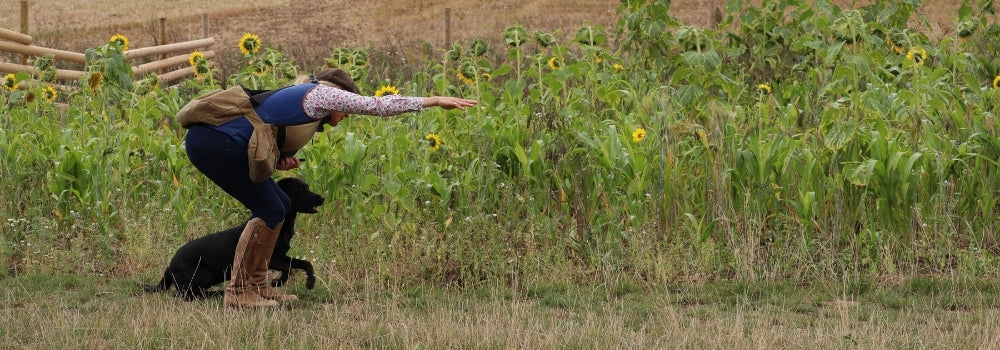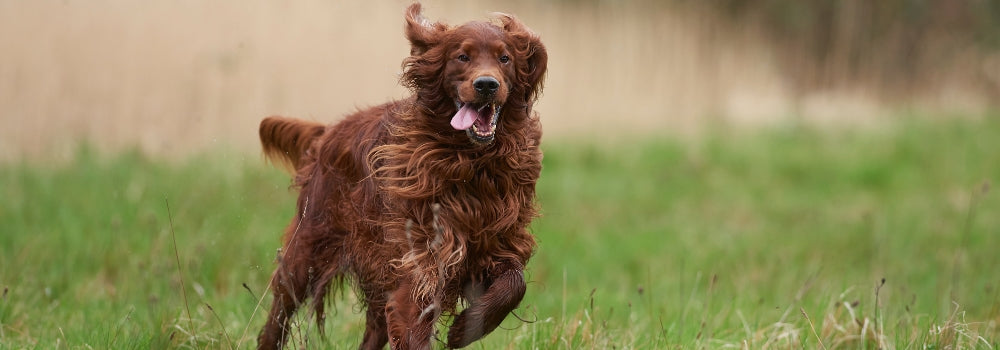Over the decades, social influences and different types of shooting have led to the evolution of a variety of different gundogs and today the Kennel Club recognises 37 breeds within the gundog category.
All gundog breeds can be effectively worked in the field for the hunting and retrieval of game, as they collectively share a multitude of common attributes like the instincts to hunt, chase and capture prey.
The preference for breeding dogs with a narrow range of highly specialised traits, however, makes them excel at particular roles in the field. This allows us to break the gundog category into four distinct subcategories - retrievers, hunting retrievers, hunt, point, retrievers (HPRs), and pointers and setters.
For puppy gundogs and youngsters, basic training is pretty much the same. There are plenty of behaviours you want to instil from the moment you bring them home, no matter what breed or role they’ll have as a pet gundog, peg dog, picking up dog or beating dog.
This is the stage at which you want to focus on building a connection and developing your relationship with them, helping them to learn how to focus in environments with lots of distractions and scents, and teaching them recall, heelwork, some self-control and steadiness, plus the early stages of hunting and the retrieve.
As our gundogs develop their learning and crack these foundation skills, our training must adapt to suit what they’ve been bred for. And so, higher level gundog group classes can then be split into the breed categories, retrievers, hunting retrievers and hunt, point, retrievers (HPRs) to ensure we can focus on nurturing and progressing breed-specific behaviours.
Many students who reach out to us with gundogs puppies (particularly those who have just got their first dog or are new to the world of gundogs) often ask what the difference is between a retriever, a hunting retriever, a HPR, and a pointer and setter.
In this month’s blog, we’ll explain the four main categories of gundog, the breeds which fit into these, and the breed-specific training you can expect to do with your dog once you’ve progressed past the foundation and graduate foundations stages.

What are retrievers?
While they can be used for rough shooting and in the beating line on driven shoots, the retriever breeds are mainly used for picking up game, an activity they will willingly and tirelessly work at all day long.
Retriever breeds examples:
- Chesapeake Bay Retriever
- Curly Coated Retriever
- Flat-coated Retriever
- Golden Retriever
- Irish Water Spaniel
- Labrador Retriever
- Nova Scotia Duck Tolling Retriever
The role of the retriever is relatively simple. They must be steady and remain in one place, usually at their handler’s side, until they are sent to collect shot game.
It is very important that they only retrieve on cue and must be able to wait patiently for long periods of time while accurately marking and remembering the location of any shot game.
Retrievers are also expected to be able to find game they didn’t see land by taking direction from their handlers. They should be able to run a straight line away from their handler and work at considerable distances, being able to stop and take direction to an area of fall before hunting tightly.
In terms of hunting and game-finding ability, retrievers need to learn to use air scent to locate a hidden bird or a bird that has dropped out of sight, as well as ground scent for locating a running bird that has been winged but not killed outright.
They are also bred for retrieving in and over water, and most retriever breeds are strong, confident swimmers with webbed paws and double ‘waterproof’ coats.
Training a retriever is often considered to be more straightforward as you don’t have to bother with quartering, pointing or the stop to flush. However, more accuracy is expected in behaviours such as heelwork, steadiness and, of course, the retrieve chain.

What are Hunting Retrievers
Also known as flushing dogs, these dogs perform excellently in dense cover and woodlands. They are not wide-ranging and are worked in close proximity to their handler, making them ideal rough shooting companions or beating dogs on driven shoots.
Hunting Retriever breeds examples:
- Cocker Spaniel
- Clumber Spaniel
- English Springer Spaniel
- Field Spaniel
- Lagotto Romagnolo
- Spanish Water Dog
- Sussex Spaniel
- Welsh Springer Spaniel
The role of the hunting retriever is first to hunt up and flush game, stopping on the flush while it is shot and then retrieving it on cue.
Our spaniels, aka hunting retrievers, have been bred to work closely. They use air scent initially and then make the transition to the ground scent to locate the quarry and not run over it.
They will work across the wind in a quartering pattern, holding their head low to locate the scent around 5 metres / 15 yards away from their handler.
This distance is important and specific because it is based on half the average range of the shotgun.
When the ground scent is located, the hunting retriever will then run around busily until the game is flushed. If the working distance were any greater, the success of the Gun would be reduced.
Spaniels need to be taught to quarter in different wind conditions, and a great deal of emphasis is placed on steadiness after the game has been flushed.
Unlike HPRs, hunting retrievers are not expected to stop still in acknowledgement of the game. They just continue to flush, stop on the flush, or shot, and then either retrieve or continue hunting.
Like retrievers, they should also be able to mark and remember where shot game has fallen and be directed to game they have not seen fall. However, unlike retrievers, spaniels are not expected to retrieve at long distances. They are also not expected to wait around for considerable amounts of time or heel for extended durations.

What are Hunt Point Retrievers (HPRs)?
Known also as versatile gundogs, the hunt, point, retrieve breeds (HPRs for short) are all-round dogs that have become increasingly popular, particularly with rough shooters, over the last few decades.
HPR breeds examples:
- Bracco Italiano
- Brittany Spaniel
- German Longhaired Pointer
- German Shorthaired Pointer
- German Wirehaired Pointer
- Hungarian Vizsla
- Hungarian Wirehaired Vizsla
- Italian Spinone
- Korthals Griffon
- Large Munsterlander
- Slovakian Rough Haired Pointer
- Small Munsterlander
- Weimaraner
The role of the HPR, as the name implies, is to hunt up game, point to it, and finally to retrieve it on cue.
HPRs use the air scent to locate their quarry when hunting. They will carry their heads at about shoulder height, dipping or lowering as they ‘taste’ the air or the conditions change.
Their beat is far greater than that of the hunting retriever simply because of the development of the pointing behaviour. This is the ability to remain still on the location of the game, which gives the Guns time to position themselves close enough in order to be able to make a successful shot.
HPRs need to develop the skill of identifying the ground scent, reading its message, and then moving back to the air scent to firm the location and point.
Like hunting retrievers, they will need to be taught to quarter in different wind conditions. They will also need to be steady to shot, mark game, and retrieve game they haven’t seen fall.

What are Pointers and Setters?
While easily confused with HPRs, pointers and setters can be grouped in their own separate category and have very different roles from the hunt, point, retriever breeds.
Pointer and Setter breeds examples:
- English Setter
- Gordon Setter
- Irish Red and White Setter
- Irish Setter
- English Pointer
- Portuguese Pointer
The role of pointers and setters is more specialists as they are bred to set or point on game birds. Rarely used for beating or retrieving, these breeds are mostly used in upland and moorland areas on heather and are often worked in a pair (called a brace).
At Clicker Gundog, pointers and setters are invited to join our HPR breed-specific groups as the hunting skills for hunt, point, retrieve breeds can be applied to training pointers and setters, in conjunction with introductions to appropriate terrain for these specialist gundogs.
If you have completed foundation gundog training and are looking to progress into breed-specific training with your retriever, hunting retriever or HPR, we run monthly group training classes here at Clicker Gundog.
For more information on our retriever group classes, click here.
For more information on our hunting retriever group classes, click here.
For more information on our HPR group classes, click here.
Please note:
This is not a definitive list. It is not possible to include every single breed and if your dog has been missed off, it was not intentional, nor was it intended to exclude any dog or breed from any group, or to exclude any dog from any job within the roles of beating, picking up or as a peg dog.
Through years of experience, I can uphold that any dog is capable of doing any activity if it has the desire and/or inclination to do so. I have spent many happy days in the beating line with German Shepherds, Collies, Labradors, Goldies, a Pug and Terriers to name but a few. Some of which have come along just for the walk, others though have been proactively engaged in the quest for quarry.
The article and accompanying social media posts were designed solely to be a guide to those who would like to know more about where their dog fits in the scheme of the bigger picture, and to those who are looking to book group classes with Clicker Gundog or to get involved with the Gundog Clubs assessments.

